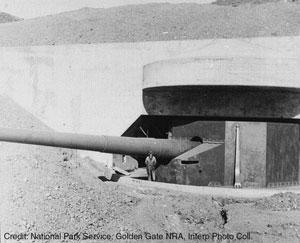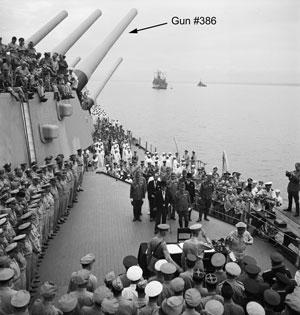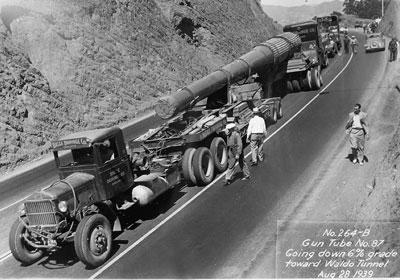In the years leading up to'and during'World War II, the technology and techniques for "homeland security" were much different than those used today. The recent arrival of a giant naval gun at Golden Gate National Recreation Area will help tell the story of coastal naval defenses during a key period in our nation's history.
Harbor Defense was Key to Nation's Security
The San Francisco Bay has been an area of strategic importance for centuries. The Spanish established the Presidio of San Francisco in 1776, and after the United States took control of California in 1848, the U.S. Army began to construct permanent posts and seacoast fortifications. By the 1850s harbor defense was viewed as a principle means of protecting the seacoasts, and therefore the entire country.
In the early 1900s San Francisco Bay was deemed second in strategic importance only to New York City, and as a result, the present-day Golden Gate National Recreation Area contains "an amazing collection of seacoast fortifications that offers examples of nearly every important development in military fortification from the Civil War to the Cold War."
One of the most impressive examples of World War II era defenses can be found at Battery Townsley in the Fort Cronkhite area of the park. In 1926 the decision was made to develop two major gun batteries to protect the Bay area, one on either side of the Golden Gate straits. By 1940, Battery Townsley was completed and its two guns installed.
The term "major gun batteries" may be a bit of an understatement. Battery Townsley was the home of a pair of 16-inch guns, each capable of shooting a 2,100-pound, armor-piercing projectile 25 miles or more out to sea. The giant weapon was 68 feet long and weighed 120 tons; its primary purpose was to keep the newest battleships of that time from reaching striking range of the coast. The guns and their associated ammunition magazines, power rooms, and crew quarters were covered by dozens of feet of concrete and earth to protect them from air and naval attack.

Battery Townsley, just after construction, photo circa 1939. Golden Gate National Recreation Area photo.
Keeping the Big Guns Under Wraps
According to a park publication, "Battery Townsley was a high security operation; civilians living in San Francisco knew that there were batteries nearby but their exact locations were not revealed. A battery of this design had never been actually fired before, so the soldiers underwent several months of practice before firing the guns for the first time."
"The men were subjected to endless training, often under difficult situations: in the rain, in the pitch dark with all the electricity shut off, or with their commanding officer blocking the traditional route to the battery. The practice of dealing with any contingency ensured that the soldiers could operate their guns at a moment's notice (and almost in their sleep) if ever under enemy attack."
That threat of enemy attack from the sea was very real during World War II, and we can be thankful the guns were never fired except for training. Technology rendered the big guns obsolete and by 1950 all of the coastal defense sites in the Bay area had been deactivated. Beginning with the establishment of Golden Gate National Recreation Area in 1972, some of these former military sites were transferred to the National Park Service.
Bringing the Past Back to Life
By the time the NPS assumed ownership of sites such as Battery Townsley, time, weather and vandalism had taken a toll. Now, thanks to work by a group of dedicated volunteers, Battery Townsley's interior is being rehabilitated, and is open to the public on the first Sunday of each month from noon to 4 PM.
Even though the site itself has been preserved and is being restored, it has been difficult for visitors to fully understand the story; it's simply beyond the ability of most of us to imagine the immense size of the guns which were once mounted here. That situation has now changed, and it's a story with several interesting historical connections.

16-inch gun #386 aboard USS Missouri during the Japanese surrender ceremonies in Tokyo Bay, 2 September 1945. The barrel was removed from the battleship turret during the Korean War and put into storage. Library of Congress photo.
Saving History from the Blowtorch
Since the end of the Korean War, one of the giant 16-inch naval guns'identical in size and caliber to the ones once placed at Battery Townsley'has been stored at the Naval Weapons Depot in Hawthorne, Nevada. Designated as U.S. Navy Mark VII #386, the gun was aboard the USS Missouri during the Japanese surrender ceremonies in Tokyo Bay on September 2, 1945. Destined for the blowtorch and scrap, it has instead found a new home at the historic battery in California.
The gun will be initially be displayed outside Battery Townsley, while plans are developed to fabricate a replica gun carriage inside the casemate (south gun room).
A park spokesperson notes, "These were the largest guns ever used by the United States military and the last of a long line of defenses that protected San Francisco Bay from the bronze cannon of the Spanish colonial era to the Nike missiles of the Cold War."
The new arrival "will be displayed as a key interpretive feature of Fort Cronkhite, helping tell the stories of Battery Townsley and the men who served here and at the other harbor defense sites during World War II, as well as the military's role in preserving the future Golden Gate National Recreation Area."
Personal Connections with the Past
Moving the giant weapon was accomplished by Bigge Crane & Rigging'the same firm that delivered the original guns to Battery Townsley in 1939. The move was made over a number of days using a ten-axle, 175-foot-long 'over the road transport' trailer, pulled and pushed simultaneously by two diesel tractors up the steep road to the battery, some 500 feet above the Pacific.
Park Superintendent Frank Dean coincidentally lived at Hawthorne Naval Weapons Depot as a teenager in 1969, when his father was the ordnance officer supervising the big gun's last overhaul.
Dean remarked, 'These park lands, once used for coastal defense, have been repurposed for environmental defense.' Since 2007 a group of dedicated volunteers has joined with the park to restore the once-abandoned and vandalized battery and open it for public programs. The volunteers also work with educators from other park partners, such as NatureBridge and the Point Bonita YMCA, to teach students about the broad range of stories in the park ' Native American, ranching, military and natural history. These outstanding volunteer efforts were recognized in 2008 with the Regional Judd Appleman Award and in 2011 with the National George Herzog Award.
Historic photos of the original gun at Battery Townsley are available at this link, , and information about how to reach the battery and view the newly arrived gun is available at the park's Marin Headlands Visitor Center.




Comments
Fascinating. Thank you, Jim.